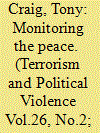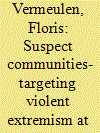|
|
|
Sort Order |
|
|
|
Items / Page
|
|
|
|
|
|
|
| Srl | Item |
| 1 |
ID:
132304


|
|
|
|
|
| Publication |
2014.
|
| Summary/Abstract |
This article presents an analysis of Al Qaeda in the Arabian Peninsula's English language publication Inspire that was conceptualized and conducted on the basis of the Information-Motivation-Behavioral Skills (IMB) framework. The IMB model has been widely tested, validated, and applied across a range of behavior change interventions, and provides both a conceptual and analytic framework to examine the range and quality of content featured across the 11 issues of Inspire that were published and distributed online starting in July of 2010. Inspire has been implicated in multiple instances of terrorism cases in the U.S. and its impact and potential can be analyzed on the extent to which it effectively targets core attitudes, perceptions of social normative support for violence, and its regular featuring of behavioral skills such as bomb making, weapons training, and emphasizing a creative and do-it-yourself ethos.
|
|
|
|
|
|
|
|
|
|
|
|
|
|
|
|
| 2 |
ID:
132305


|
|
|
|
|
| Publication |
2014.
|
| Summary/Abstract |
This note describes a new and unique, open source, relational database called the United States Extremist Crime Database (ECDB). We first explain how the ECDB was created and outline its distinguishing features in terms of inclusion criteria and assessment of ideological commitment. Second, the article discusses issues related to the evaluation of the ECDB, such as reliability and selectivity. Third, descriptive results are provided to illustrate the contributions that the ECDB can make to research on terrorism and criminology.
|
|
|
|
|
|
|
|
|
|
|
|
|
|
|
|
| 3 |
ID:
132289


|
|
|
|
|
| Publication |
2014.
|
| Summary/Abstract |
Islam's diversity is a direct result of centuries of schism and factionalism, and presents a challenge to the original spirit of unity as envisaged by its founder, the Prophet Mohammed. Rivalry within Islam undermines the precedent notion of unity through communal belonging (tawhid and ummah). Yet in the twenty-first century this diversity is ignored, and political Islam is represented as being more of a monolith than a spectrum of ideas and aspirations. Generally, the materialization of new Islamist groups is a challenge to those who hold that unity is all. In the Gaza Strip, specifically, the dominant Islamist actor, Hamas, is facing internal challenges from other Islamist elements. These rival Islamists are also influenced by events across their border in post-revolutionary Egypt where a plethora of new Islamist actors are vying for political space and power. This article deals with Hamas's Islamist rivals, and the effects they have had on Hamas's governance of the Gaza Strip, and political and religious legitimacy within it. It will focus on ideological and violent disputes between the Islamist elements in Gaza, and the means by which Hamas and its security elements have tackled newly emerging rivals.
|
|
|
|
|
|
|
|
|
|
|
|
|
|
|
|
| 4 |
ID:
132301


|
|
|
|
|
| Publication |
2014.
|
| Summary/Abstract |
During the Provisional IRA's (PIRA) 1975 ceasefire, two different sets of incident centres were established across Northern Ireland in order to monitor and avert escalation of violence between Republicans and Security Forces. While one group of offices was run by the Northern Ireland Office (NIO) and administered by clerks in the Northern Ireland Civil Service, very quickly Sinn Féin (taking advantage of their decriminalisation in 1974) established their own incident centres to coordinate their communication with the government. This article argues that the establishment of the Sinn Féin incident centres set a precedent for the future political activity of the Provisional Republican Movement; that their activity during the 1975 ceasefire played an important formative role in the evolution of the group's political strategy; and that this experience, acquired from the work done during the 1975 truce, was of far greater influence than is appreciated in current accounts.
|
|
|
|
|
|
|
|
|
|
|
|
|
|
|
|
| 5 |
ID:
132303


|
|
|
|
|
| Publication |
2014.
|
| Summary/Abstract |
Although much has been written about how and why individuals become terrorists, very little research has focused on why individuals choose not to become involved in political violence. Some assume that these non-radicalized individuals simply have not had the same life experiences as terrorists. Yet one only has to explore areas of conflict, such as the Gaza Strip, northwest Pakistan, or the southern Philippines, to wonder why more individuals have not joined local militant groups. This article presents a conceptual model ofnon-radicalization in an attempt to move the discussion forward on this topic. It argues that it is impossible to understand radicalization pathways, or design policies to preempt them, without a complementary knowledge ofwhy individuals resist the influence ofviolent extremism.
|
|
|
|
|
|
|
|
|
|
|
|
|
|
|
|
| 6 |
ID:
132294


|
|
|
|
|
| Publication |
2014.
|
| Summary/Abstract |
Throughout Europe, authorities have set up new policy measures and programs to curb homegrown violent extremists. This article describes local policy responses to violent Islamic extremism-and/or the mere threat of it-in the neighborhoods Oost in Amsterdam, Moabit and Soldiner Kiez in Berlin, and Tower Hamlets in London. Based on locally conducted fieldwork, the study compares and contrasts these neighborhoods' approaches and aims to make a first assessment of their effects. A major finding for all three cities is that authorities target the entire local Muslim community rather than a few select individuals. This can lead to the construction of suspect communities, an approach with possible paradoxical effects on targeting actual violent extremists. Suspect communities subsequently create stigmatization, exclusion, and possibly marginalization, which not only has negative consequences for involved groups, but may well produce a breeding ground for future violence. However, the author did not find that engagement with Islamic organizations or individuals was used to directly change the nature of local Muslim communities. Orthodox and non-violent extremist organizations and individuals in all three cities were potential partners for engagement, which probably lowers the chance of stigmatizing the suspect communities.
|
|
|
|
|
|
|
|
|
|
|
|
|
|
|
|
| 7 |
ID:
132302


|
|
|
|
|
| Publication |
2014.
|
| Summary/Abstract |
It has been suggested that a nexus between terrorist groups and those involved in organised crime exists. This study explores the co-operative possibilities that exist between these phenomena, focusing specifically on the level of assistance participants in organised criminal activity might provide to those engaged in terrorism, the "initial nexus." This was achieved initially through interviews with subject matter experts with knowledge of the organised crime and counter terrorism situation in Scotland. Thereafter, law enforcement personnel who investigate serious and organised crime were interviewed, and their opinions sought in respect of the likely actions of those they investigate. The data gathered is subject to analysis and comment are provided as to what level of co-operation between those involved in organised crime and terrorism can be expected; what motivational factors may have a bearing on the level of co-operation provided; and discussion of "tipping points," ethical or otherwise, where the withdrawal of co-operation could occur, providing opportunities for increasingly successful law enforcement intervention.
|
|
|
|
|
|
|
|
|
|
|
|
|
|
|
|
| 8 |
ID:
132293


|
|
|
|
|
| Publication |
2014.
|
| Summary/Abstract |
For nearly ten years the Colombian government has systematically debriefed men and women who have left the Revolutionary Armed Forces of Colombia (FARC) and other violent extremist organizations. Today, the Colombian government maintains a database of more than 15,000 digitized interview transcripts-the largest of its kind in the world. With the proper enhancements and analysis, the database can provide critical insights into topics such as extremist recruitment, motivation, information operations, intelligence activities, leadership, and tactical and operational adaptation and innovation. Although Colombia's political violence is unique in many respects, further research using the database contributes to our understanding of the dynamics of insurgency in other regions. Ultimately, this research could enhance efforts to prevent recruitment into, and encourage current members to exit from violent non-state groups, such as gangs, terrorist groups, militias, and drug trafficking organizations.
|
|
|
|
|
|
|
|
|
|
|
|
|
|
|
|
|
|
|
|
|